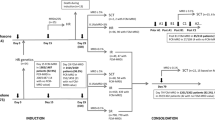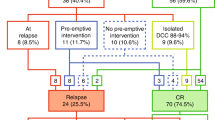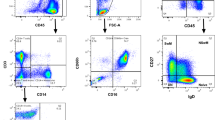Abstract
Chronic myeloid leukemia (CML) relapse after allogeneic stem cell transplantation (SCT) is a relatively frequent situation, which is correlated to disease status, time from diagnosis to transplant and T-cell depletion. We evaluated the potential for early minimal residual disease (MRD) BCR-ABL quantification to predict relapse of CML patients receiving allogeneic SCT. Minimal residual disease was analyzed by real-time quantitative reverse transcriptase-polymerase chain reaction (RQ-PCR) at day 100 (d100) in 38 patients with >1 year follow-up after conventional non-T-cell-depleted SCT. Normal ABL control values from 1724 follow-up blood samples were used to define an RQ-PCR amplifiability index and the limits of reliable use of BCR-ABL ratios. We then compared the 14 patients with a high-level d100 BCR-ABL/ABL ratio (⩾10−4) to that of the 24 patients with a negative/low-level ratio (<10−4). Despite being comparable for all classical parameters, the incidence of relapse was significantly higher in the high MRD group (11/14 (79%)) compared to that of the low/negative MRD group (7/24 (29%)) (P=0.009), with d100 MRD values representing an independent risk factor of relapse and disease-free survival, but not of overall survival, in multivariate analysis. These data should facilitate risk-adapted post-transplant immunosuppression and/or tyrosine kinase inhibitor therapy based on an early evaluation of MRD.
This is a preview of subscription content, access via your institution
Access options
Subscribe to this journal
Receive 12 print issues and online access
$259.00 per year
only $21.58 per issue
Buy this article
- Purchase on Springer Link
- Instant access to full article PDF
Prices may be subject to local taxes which are calculated during checkout



Similar content being viewed by others
References
Goldman JM, Apperley JF, Jones L, Marcus R, Goolden AW, Batchelor R et al. Bone marrow transplantation for patients with chronic myeloid leukemia. N Engl J Med 1986; 314: 202–207.
Speck B, Bortin MM, Champlin R, Goldman JM, Herzig RH, McGlave PB et al. Allogeneic bone-marrow transplantation for chronic myelogenous leukaemia. Lancet 1984; 1: 665–668.
Gale RP, Hehlmann R, Zhang MJ, Hasford J, Goldman JM, Heimpel H et al. Survival with bone marrow transplantation versus hydroxyurea or interferon for chronic myelogenous leukemia. The German CML Study Group. Blood 1998; 91: 1810–1819.
Goldman JM, Gale RP, Horowitz MM, Biggs JC, Champlin RE, Gluckman E et al. Bone marrow transplantation for chronic myelogenous leukemia in chronic phase. Increased risk for relapse associated with T-cell depletion. Ann Intern Med 1988; 108: 806–814.
Champlin RE, Golde DW . Chronic myelogenous leukemia: recent advances. Blood 1985; 65: 1039–1047.
Thomas ED, Clift RA, Fefer A, Appelbaum FR, Beatty P, Bensinger WI et al. Marrow transplantation for the treatment of chronic myelogenous leukemia. Ann Intern Med 1986; 104: 155–163.
Gabert J, Thuret I, Lafage M, Carcassonne Y, Maraninchi D, Mannoni P . Detection of residual bcr/abl translocation by polymerase chain reaction in chronic myeloid leukaemia patients after bone-marrow transplantation. Lancet 1989; 2: 1125–1128.
Hughes TP, O'Shea P, Morgan G, Martiat P, Goldman JM . Persistence of BCR/ABL transcripts after BMT for CML detected by PCR reflects a high risk of relapse. Bone Marrow Transplant 1991; 7 (Suppl 2): 23.
Morgan GJ, Hughes T, Janssen JW, Gow J, Guo AP, Goldman JM et al. Polymerase chain reaction for detection of residual leukaemia. Lancet 1989; 1: 928–929.
Pignon JM, Henni T, Amselem S, Vidaud M, Duquesnoy P, Vernant JP et al. Frequent detection of minimal residual disease by use of the polymerase chain reaction in long-term survivors after bone marrow transplantation for chronic myeloid leukemia. Leukemia 1990; 4: 83–86.
Roth MS, Antin JH, Ash R, Terry VH, Gotlieb M, Silver SM et al. Prognostic significance of Philadelphia chromosome-positive cells detected by the polymerase chain reaction after allogeneic bone marrow transplant for chronic myelogenous leukemia. Blood 1992; 79: 276–282.
Sawyers CL, Timson L, Kawasaki ES, Clark SS, Witte ON, Champlin R . Molecular relapse in chronic myelogenous leukemia patients after bone marrow transplantation detected by polymerase chain reaction. Proc Natl Acad Sci USA 1990; 87: 563–567.
Delage R, Soiffer RJ, Dear K, Ritz J . Clinical significance of bcr-abl gene rearrangement detected by polymerase chain reaction after allogeneic bone marrow transplantation in chronic myelogenous leukemia. Blood 1991; 78: 2759–2767.
Radich JP, Gehly G, Gooley T, Bryant E, Clift RA, Collins S et al. Polymerase chain reaction detection of the BCR-ABL fusion transcript after allogeneic marrow transplantation for chronic myeloid leukemia: results and implications in 346 patients. Blood 1995; 85: 2632–2638.
Olavarria E, Kanfer E, Szydlo R, Kaeda J, Rezvani K, Cwynarski K et al. Early detection of BCR-ABL transcripts by quantitative reverse transcriptase-polymerase chain reaction predicts outcome after allogeneic stem cell transplantation for chronic myeloid leukemia. Blood 2001; 97: 1560–1565.
Lange T, Deininger M, Brand R, Hegenbart U, Al-Ali H, Krahl R et al. BCR-ABL transcripts are early predictors for hematological relapse in chronic myeloid leukemia after hematopoietic cell transplantation with reduced intensity conditioning. Leukemia 2004; 18: 1468–1475.
Preudhomme C, Revillion F, Merlat A, Hornez L, Roumier C, Duflos-Grardel N et al. Detection of BCR-ABL transcripts in chronic myeloid leukemia (CML) using a ‘real time’ quantitative RT-PCR assay. Leukemia 1999; 13: 957–964.
Radich JP, Gooley T, Bryant E, Chauncey T, Clift R, Beppu L et al. The significance of bcr-abl molecular detection in chronic myeloid leukemia patients ‘late,’ 18 months or more after transplantation. Blood 2001; 98: 1701–1707.
Kim YJ, Kim DW, Lee S, Kim HJ, Kim YL, Hwang JY et al. Comprehensive comparison of FISH, RT-PCR, and RQ-PCR for monitoring the BCR-ABL gene after hematopoietic stem cell transplantation in CML. Eur J Haematol 2002; 68: 272–280.
Beillard E, Pallisgaard N, van der Velden VH, Bi W, Dee R, van der Schoot E et al. Evaluation of candidate control genes for diagnosis and residual disease detection in leukemic patients using ‘real-time’ quantitative reverse-transcriptase polymerase chain reaction (RQ-PCR) – a Europe against cancer program. Leukemia 2003; 17: 2474–2486.
Damaj G, Delabesse E, Le Bihan C, Asnafi V, Rachid M, Lefrere F et al. Typical essential thrombocythaemia does not express bcr-abelson fusion transcript. Br J Haematol 2002; 116: 812–816.
Gabert J, Beillard E, van der Velden VH, Bi W, Grimwade D, Pallisgaard N et al. Standardization and quality control studies of ‘real-time’ quantitative reverse transcriptase polymerase chain reaction of fusion gene transcripts for residual disease detection in leukemia – a Europe Against Cancer program. Leukemia 2003; 17: 2318–2357.
Kaplan E, Meier P . Non-parametric estimation from incomplete observations. J Am Stat Assoc 1958; 53: 457–481.
Mantel N . Evaluation of survival data and two new rank order statistics arising in its consideration. Cancer Chemother Rep 1966; 50: 163–170.
Cox D . Regression models and life tables. J Roy Stat Sco 1972; 34: 187–220.
Druker BJ, Talpaz M, Resta DJ, Peng B, Buchdunger E, Ford JM et al. Efficacy and safety of a specific inhibitor of the BCR-ABL tyrosine kinase in chronic myeloid leukemia. N Engl J Med 2001; 344: 1031–1037.
Kantarjian H, Sawyers C, Hochhaus A, Guilhot F, Schiffer C, Gambacorti-Passerini C et al. Hematologic and cytogenetic responses to imatinib mesylate in chronic myelogenous leukemia. N Engl J Med 2002; 346: 645–652.
O'Brien SG, Guilhot F, Larson RA, Gathmann I, Baccarani M, Cervantes F et al. Imatinib compared with interferon and low-dose cytarabine for newly diagnosed chronic-phase chronic myeloid leukemia. N Engl J Med 2003; 348: 994–1004.
Martinelli G, Soverini S, Rosti G, Cilloni D, Baccarani M . New tyrosine kinase inhibitors in chronic myeloid leukemia. Haematologica 2005; 90: 534–541.
Shah NP . Loss of response to imatinib: mechanisms and management. Hematology (Am Soc Hematol Educ Program) 2005, 183–187.
Yamamoto M, Kurosu T, Kakihana K, Mizuchi D, Miura O . The two major imatinib resistance mutations E255K and T315I enhance the activity of BCR/ABL fusion kinase. Biochem Biophys Res Commun 2004; 319: 1272–1275.
Copelan EA, Penza SL, Theil KS, Elder PJ, Bechtel TP, Tighe MB et al. The influence of early transplantation, age, GVHD prevention regimen, and other factors on outcome of allogeneic transplantation for CML following BuCy. Bone Marrow Transplant 2000; 26: 1037–1043.
Gratwohl A, Hermans J, Goldman JM, Arcese W, Carreras E, Devergie A et al. Risk assessment for patients with chronic myeloid leukaemia before allogeneic blood or marrow transplantation. Chronic Leukemia Working Party of the European Group for Blood and Marrow Transplantation. Lancet 1998; 352: 1087–1092.
Sokal JE, Baccarani M, Tura S, Fiacchini M, Cervantes F, Rozman C et al. Prognostic discrimination among younger patients with chronic granulocytic leukemia: relevance to bone marrow transplantation. Blood 1985; 66: 1352–1357.
Acknowledgements
This work was supported by the ‘Fondation contre la leucémie de la Fondation de France’, the ‘Ligue Nationale Contre le Cancer’ and the ‘Association de la Recherche sur le Cancer (ARC)’.
Author information
Authors and Affiliations
Corresponding author
Rights and permissions
About this article
Cite this article
Asnafi, V., Rubio, MT., Delabesse, E. et al. Prediction of relapse by day 100 BCR-ABL quantification after allogeneic stem cell transplantation for chronic myeloid leukemia. Leukemia 20, 793–799 (2006). https://doi.org/10.1038/sj.leu.2404170
Received:
Accepted:
Published:
Issue Date:
DOI: https://doi.org/10.1038/sj.leu.2404170
Keywords
This article is cited by
-
Minimal residual disease diagnostics in myeloid malignancies in the post transplant period
Bone Marrow Transplantation (2008)



